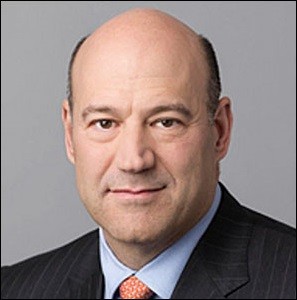By Pam Martens and Russ Martens: April 17, 2017

Gary Cohn, former President and COO of Goldman Sachs, Is Director of the National Economic Council in the Trump Administration
There are a few important things to know about Gary Cohn. Until Donald Trump tapped him to be the Director of the National Economic Council, he had worked at Goldman Sachs for a quarter century, rising to the position of President of the firm and second only to its CEO, Lloyd Blankfein. Cohn walked out of Goldman in December with approximately $285 million, comprised mainly of Goldman stock, some of which had been granted early vesting. Since his exit from Goldman, Cohn has wasted no time in selling large chunks of his Goldman shares according to his financial disclosures. While this serves to reduce his conflicts of interest with Goldman, it also provides a face-saving means of exiting a massive position in a Wall Street bank without the appearance of panic or disloyalty.
Against this backdrop comes the widely reported news that on April 5 Cohn met with Senators serving on the Senate Banking Committee and expressed support for bringing back a modern-day version of the depression era Glass-Steagall Act – legislation which was passed as a result of the Wall Street collapse of 1929 to 1933, which erased 90 percent of the market’s value. (Yes, 90 percent.) That legislation created Federally-insured deposits and barred insured commercial banks from being affiliated with Wall Street investment banks. It protected the U.S. financial system for 66 years until its repeal in 1999 under the Bill Clinton administration. It took only nine years after its repeal for Wall Street to implode in the same epic fashion as the ’29 crash.
The only reason that Wall Street survived at all from 2008 to 2010 was that the Federal Reserve was secretly funneling a cumulative $16 trillion in almost zero rate loans to any Wall Street bank, foreign or domestic, that could fog a mirror and claim to be viable. On top of that, the Fed engaged in a toxic securities cleanup program benignly known as Quantitative Easing, where it bought up Wall Street’s dodgy mortgage-backed securities, putting the mess on its own balance sheet — where much of it remains to this day.
Theories abound as to why a long-tenured veteran of Goldman would want to earn the ire and backlash of his colleagues on Wall Street by taking on such an unpopular Wall Street position as breaking up the biggest banks on Wall Street and forcing them to shed their commercial banking operations. Goldman itself became a bank holding company at the peak of the financial crisis in 2008, allowing it to borrow with abandon from the Fed.
One theory is that Cohn is still talking his Goldman book. Patrick Jenkins of the Financial Times writes:
“But Glass-Steagall is not exactly anti-Wall Street. It is anti-universal bank. So while it would be a nightmare for Goldman Sachs’s big investment banking competitors, it would be a relative non-event for Goldman Sachs itself. In competitive terms, it could be a huge boost.”
It’s true that Goldman’s commercial banking operations are dwarfed by the likes of JPMorgan Chase, Bank of America, Citigroup and Wells Fargo — all of which function as universal banks with investment banking, brokerage firms, and commercial banking under one bank holding company roof. But what people tend to forget is that Goldman Sachs has parked a mind-numbing amount of derivatives at its own commercial bank, Goldman Sachs Bank USA.
Wall Street On Parade reported the following on this matter in January:
“The Office of the Comptroller of the Currency (OCC) is the regulator of national banks. Each quarter it publishes a report on the derivative holdings of the biggest Wall Street banks and their holding companies. Its most recent report shows that as of September 30, 2016 Goldman Sachs Bank USA (a taxpayer-backstopped, FDIC insured bank where it holds its derivatives) had “credit exposure to risk-based capital” of 433 percent. That figure was more than double that of JPMorgan Chase (216 percent) and six times that of Bank of America (68 percent).
“There’s another big problem with Goldman Sachs: it has a miniscule asset base compared to the big guns on Wall Street but it’s attempting to play in the big leagues in terms of derivatives…Goldman Sachs is the third largest holder of derivatives on Wall Street with $45.48 trillion in notionals (face amount). (As of 2015, the entire GDP of the United States was only $18 trillion.) But Goldman only has $880 billion in assets. That ratio compares to JPMorgan Chase with $2.5 trillion in assets and $50.6 trillion in derivatives and Citigroup with $1.8 trillion in assets and $51.78 trillion in derivatives.”
The theory that has yet to gain traction is that there may be many more executives at Goldman who agree with Cohn on the point that the financial system remains on shaky footing and that holding high-risk derivatives in the trillions of dollars on the books of taxpayer-backstopped commercial banks is a lousy way to run a financial system — that it is simply courting the next financial disaster and taxpayer bailout from a nation that has yet to recover from the last one.

